Liveaboard: Okeanos Aggressor
Hiding in plain sight is my goal as I slowly slip beneath swarming blue-and-gold snappers and big-scale soldierfish that carpet the boulders on the sloping outer wall of Manuelita Island. A living camouflage of fish swirls about my head, while the barnacle-laced rock both shields me from the strong current and serves as the front wall of my makeshift blind. I am not on a rebreather, but the 2-knot current dissipates my noisy bubbles and quickly carries them away from my quarry.
The objects of my desire are the 100-plus muscular scalloped hammerhead sharks that are combing the sand at 110 feet, then circling back to busy cleaning stations near my position at 70 feet. Stealth is essential if I am to fill my viewfinder with the elongated head of one of these otherworldly creatures as it stops for industrious barberfish and king angels to clean mating wounds and similar sensitive areas.
Distractions abound as the minutes tick past. Countless creolefish extend to the surface, each seeming to dance to its own melody. A fine spotted moray hunts with our leather bass that stop to investigate a prickly black sea urchin. Large marble rays and patrolling whitetip reef sharks repeatedly cruise past. Just when I start to feel at ease with the abundant life encircling me, chaos reigns supreme.
Scalloped hammerheads sweep over the reef en masse. I fire in bursts of two to three shots as I pan my camera from one shark to another. The unrelenting action momentarily overwhelms my senses and leaves me in awe. Then, emerging from the haze of the nutrient-rich water, a 25-foot juvenile whale shark takes center stage. Suddenly heedless, I leave the security of my VIP seating to swim alongside the largest species of fish in the sea.
This massive whale shark hosts an astounding number of groupies that actually resemble the handiwork of some deranged fashion designer. Remoras clinging to its prodigious tail look like decorative flags, while others form a pseudo mustache and goatee as they are either packed inside the shark’s wide maw or riding upside down underneath it. There are even remoras stuffed inside its spiracles like radical head piercings.
Manuelita is only one of many electrifying dive sites around Costa Rica’s Cocos Island. This former pirate haven is 340 miles off the Costa Rican mainland in the eastern Pacific Ocean.
Cocos is the epitome of raw, wilderness diving. No other location offers the same dynamic, heart-pounding opportunities to dive with pelagics such as billfish, marine mammals, rays and sharks year-round. It’s not unusual for divers to see six species of shark — Galapagos, scalloped hammerhead, silky, tiger, whale and whitetip reef — on a single dive. Even marine mammals like bottlenose dolphin, false killer whales, humpback whales, killer whales and pilot whales are no strangers to the underwater playground of Cocos. The most productive pelagic hot spots are usually Alcyone, Dirty Rock, Manuelita and Punta Maria.
Legends of buried pirate booty have clung to Cocos through the ages. Though no golden doubloons have ever been found — or, at least, not publicized — small natural treasures abound on every site. It’s so easy to be fixated on the big prizes here that smaller jewels lie in anonymity. For instance, Manuelita’s protected coral gardens are home to stately Commerson’s frogfish and endemic red or rosy-lipped batfish.
Need To Know
- When to Go Diving is good year-round. The rainy season (June to November) offers opportunities to swim with large schools of scalloped hammerheads but presents more-challenging conditions.
- Dive Conditions In the blink of an eye, conditions can change from site to site. Water temperatures range from 75 degrees F in the rainy season to 82 in the dry season. Thermoclines can drop temps 10 degrees. Visibility varies from 50 feet in the rainy season to more than 100 feet in the dry season.
- Logistics An overnight stay in San Jose is required upon arrival. The Okeanos Aggressor crew takes guests from San Jose to Puntarenas the following morning. All trips are 10 days long, with seven days of diving. Return transportation to San Jose is also provided.
- Operator Okeanos Aggressor is part of the Aggressor and Dancer Fleet.
- Price Tag A deluxe stateroom with a single and double bed is $4,935 per person; the quad stateroom with two double and two single beds is $4,535 per person.
Okeanos Aggressor
A liveaboard — and a 36-hour crossing — is the only way to reach and dive this remote, uninhabited paradise. A visit to this World Heritage site and the crown jewel of the country’s park system is a rare privilege that many consider the trip of a lifetime. Okeanos Aggressor is a luxury dive yacht that has been pampering divers from around the globe on Cocos Island charters since 1988. This vessel remains a cornerstone of the most successful and longest-standing fleet of premium liveaboards in the world. As such, it offers all the attention to details and first-class service that discriminating divers have come to expect from the Aggressor Fleet.
This powerful vessel was built to withstand the rigorous demands of open-ocean crossings, and is outfitted to cater to 22 passengers in style and comfort.
At a length of 110 feet and with a beam of 24 feet, Okeanos Aggressor features spacious accommodations, 10 staterooms with individual climate control, en-suite bathrooms and TV/DVD, as well as an expansive dive deck that gives photographers and nonphotographers alike plenty of room to don wetsuits and tinker with gear. Gourmet meals are served in a dedicated dining room. Sun lovers can soak in the rays on two different decks.
Three to four dives per day are conducted from a pair of nimble, 22-foot-long pangas. Currents, surge, thermoclines, visibility and animal sightings can change dramatically from one dive to the next: The experienced dive guides and panga drivers intimately know the sites, and put divers in the safest and most advantageous spots on each dive. Capt. Alberto “Beto” Muñoz has faithfully and passionately served on Okeanos Aggressor for the past 20 years, and still joyfully expects the unexpected on each and every dive.
Ten days aboard and a full week of diving Cocos flies past entirely too quickly. The lengthy return crossing offers plenty of time to dry and pack gear, read a book, watch movies, share tall tales with fellow divers, and rest before returning to the mainland. It is not, however, long enough to wrap my mind around the high-octane dives flush with exotic life, or the idyllic, tranquil settings that are so far removed from modern civilization. How can I adequately give anyone a true taste of what it’s like to get hammered at Cocos? I can’t. So I’ll just enjoy being pampered a little while longer while I try to figure out how I can swing another adventure aboard the Okeanos Aggressor.
5 Reasons To Dive Cocos From Okeanos Aggressor
1. Hammer Time
Schooling scalloped hammerheads symbolize the pelagic parade in the waters of Cocos Island throughout the year. The Okeanos Aggressor crew knows the prime parade routes and how to put their guests in front-row seats.
2. The Drama
Each dive site stages a never-ending drama of animal interactions and shifting marine forces. Cocos allows divers to look behind the curtains to see the raw, wild side of nature.
3. The Weird
Small, a-face- only-a-mother-could-love creatures — such as the Commerson’s frogfish and endemic red or rosy-lipped batfish — should not be missed.
4. The Beauty
Cocos is the only island in the eastern pacific that supports high-altitude cloud and tropical rainforests. About 200 waterfalls punctuate the lush landscape. Okeanos Aggressor’s decks let you soak in the intoxicating beauty.
5. Consistency
Okeanos Aggressor offers the same high standards of excellence in safety, service, comfort and guest satisfaction that are hallmarks of all Aggressor Fleet dive yachts.
Check out the entire slate of liveaboard itineraries offered by the Aggressor and Dancer Fleet!
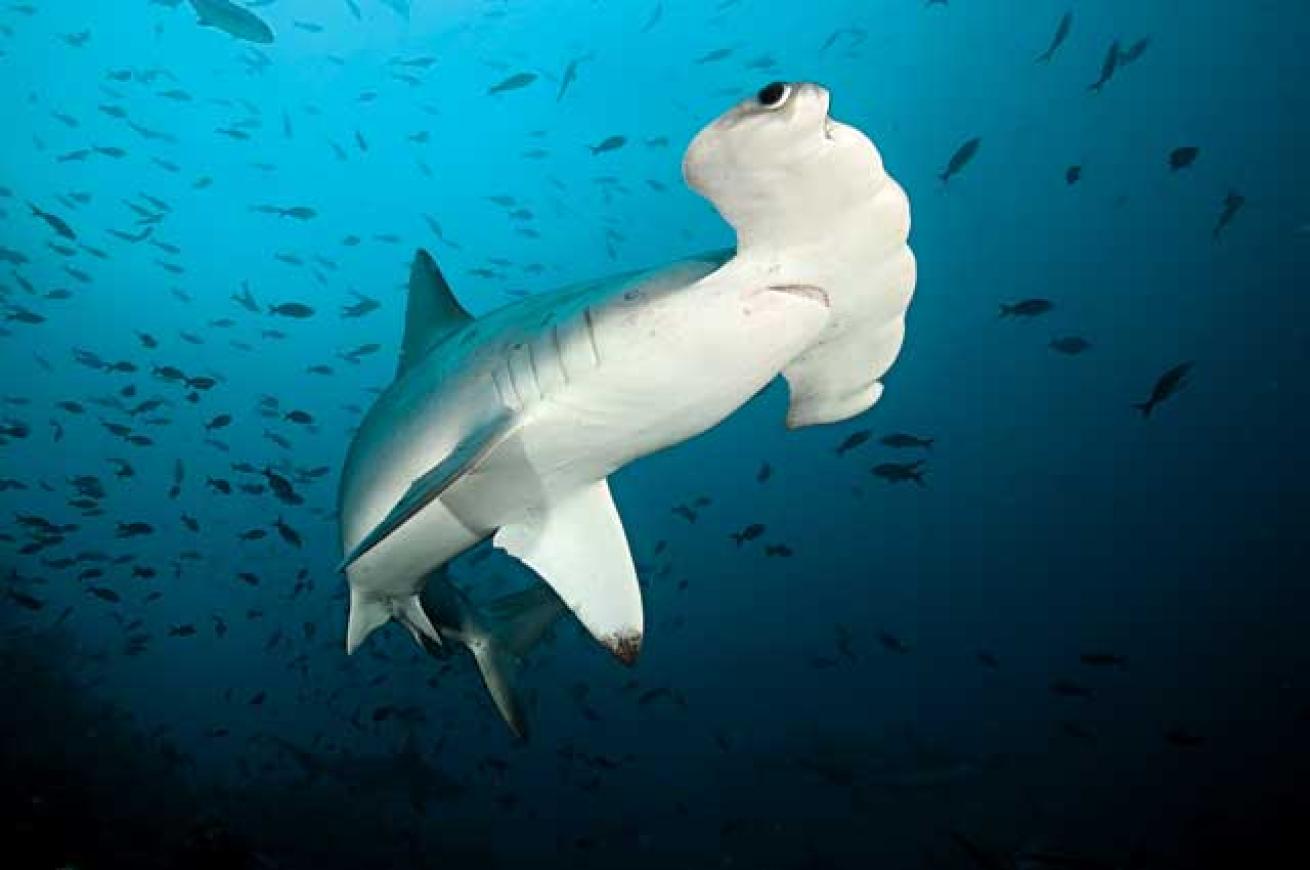
Scott JohnsonUp close with a scalloped hammerhead.
Hiding in plain sight is my goal as I slowly slip beneath swarming blue-and-gold snappers and big-scale soldierfish that carpet the boulders on the sloping outer wall of Manuelita Island. A living camouflage of fish swirls about my head, while the barnacle-laced rock both shields me from the strong current and serves as the front wall of my makeshift blind. I am not on a rebreather, but the 2-knot current dissipates my noisy bubbles and quickly carries them away from my quarry.
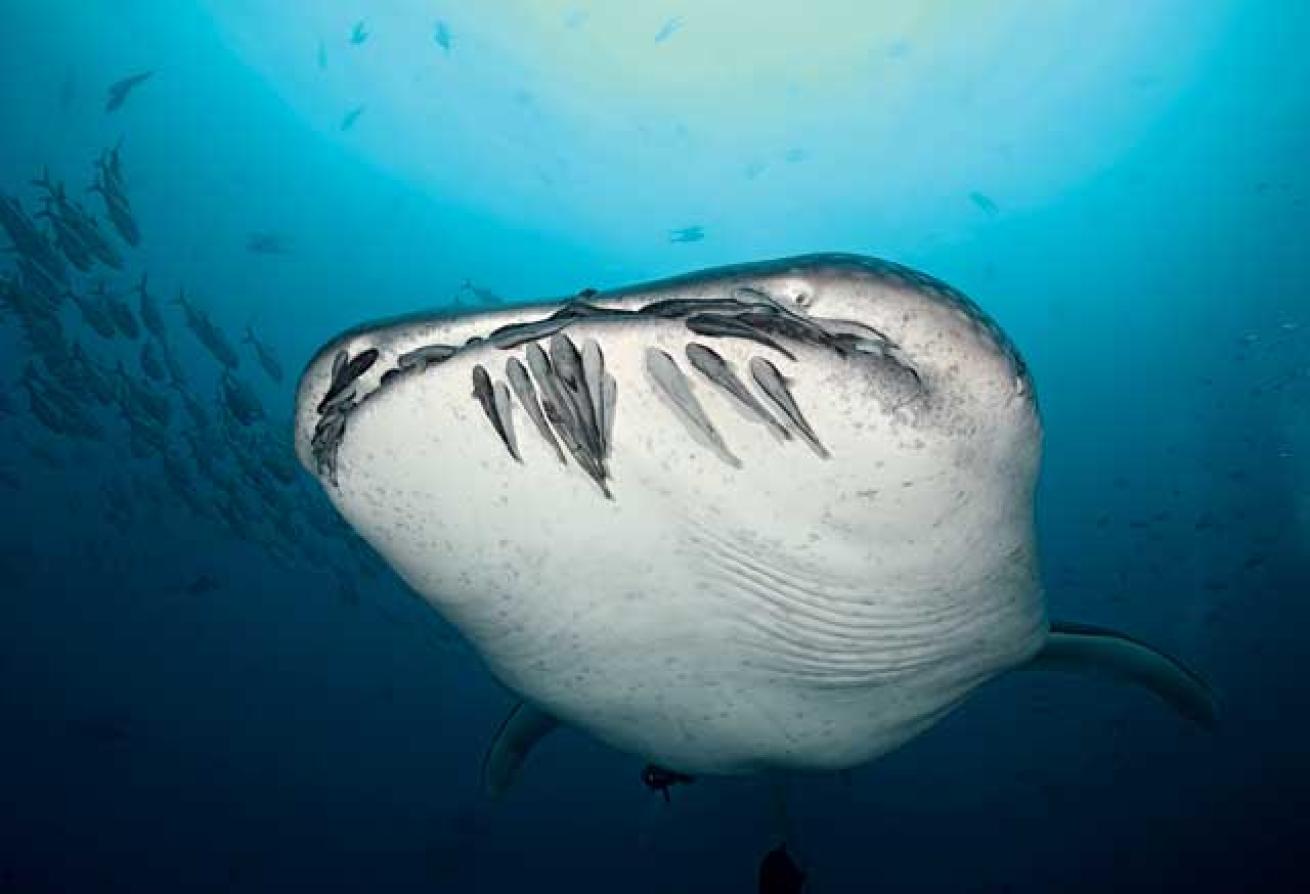
Scott JohnsonEncountering a whale shark at Dirty Rock.
The objects of my desire are the 100-plus muscular scalloped hammerhead sharks that are combing the sand at 110 feet, then circling back to busy cleaning stations near my position at 70 feet. Stealth is essential if I am to fill my viewfinder with the elongated head of one of these otherworldly creatures as it stops for industrious barberfish and king angels to clean mating wounds and similar sensitive areas.
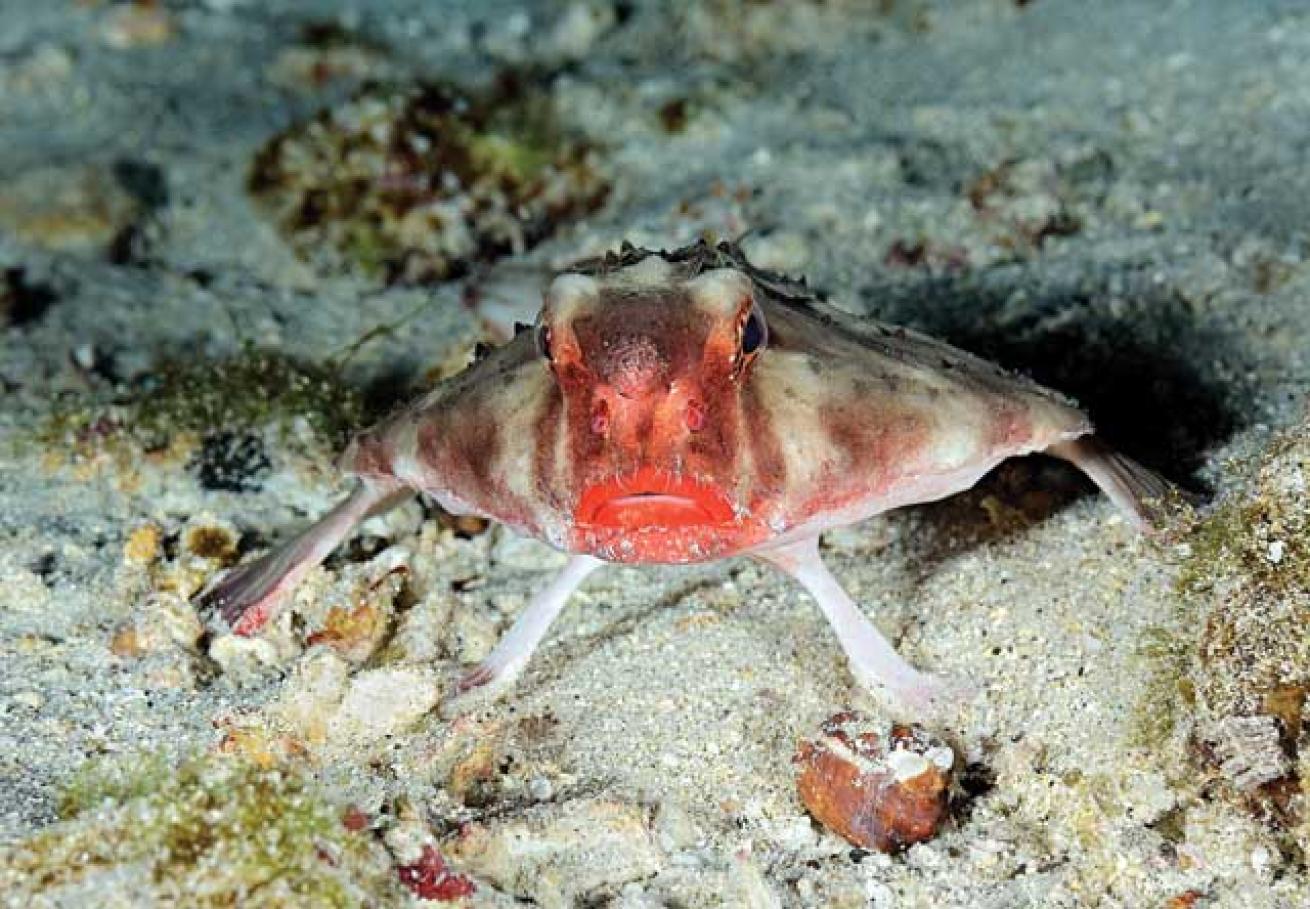
Scott JohnsonAn endemic red or rosy-lipped batfish in Manuelita’s coral gardens.
Distractions abound as the minutes tick past. Countless creolefish extend to the surface, each seeming to dance to its own melody. A fine spotted moray hunts with our leather bass that stop to investigate a prickly black sea urchin. Large marble rays and patrolling whitetip reef sharks repeatedly cruise past. Just when I start to feel at ease with the abundant life encircling me, chaos reigns supreme.
Scalloped hammerheads sweep over the reef en masse. I fire in bursts of two to three shots as I pan my camera from one shark to another. The unrelenting action momentarily overwhelms my senses and leaves me in awe. Then, emerging from the haze of the nutrient-rich water, a 25-foot juvenile whale shark takes center stage. Suddenly heedless, I leave the security of my VIP seating to swim alongside the largest species of fish in the sea.
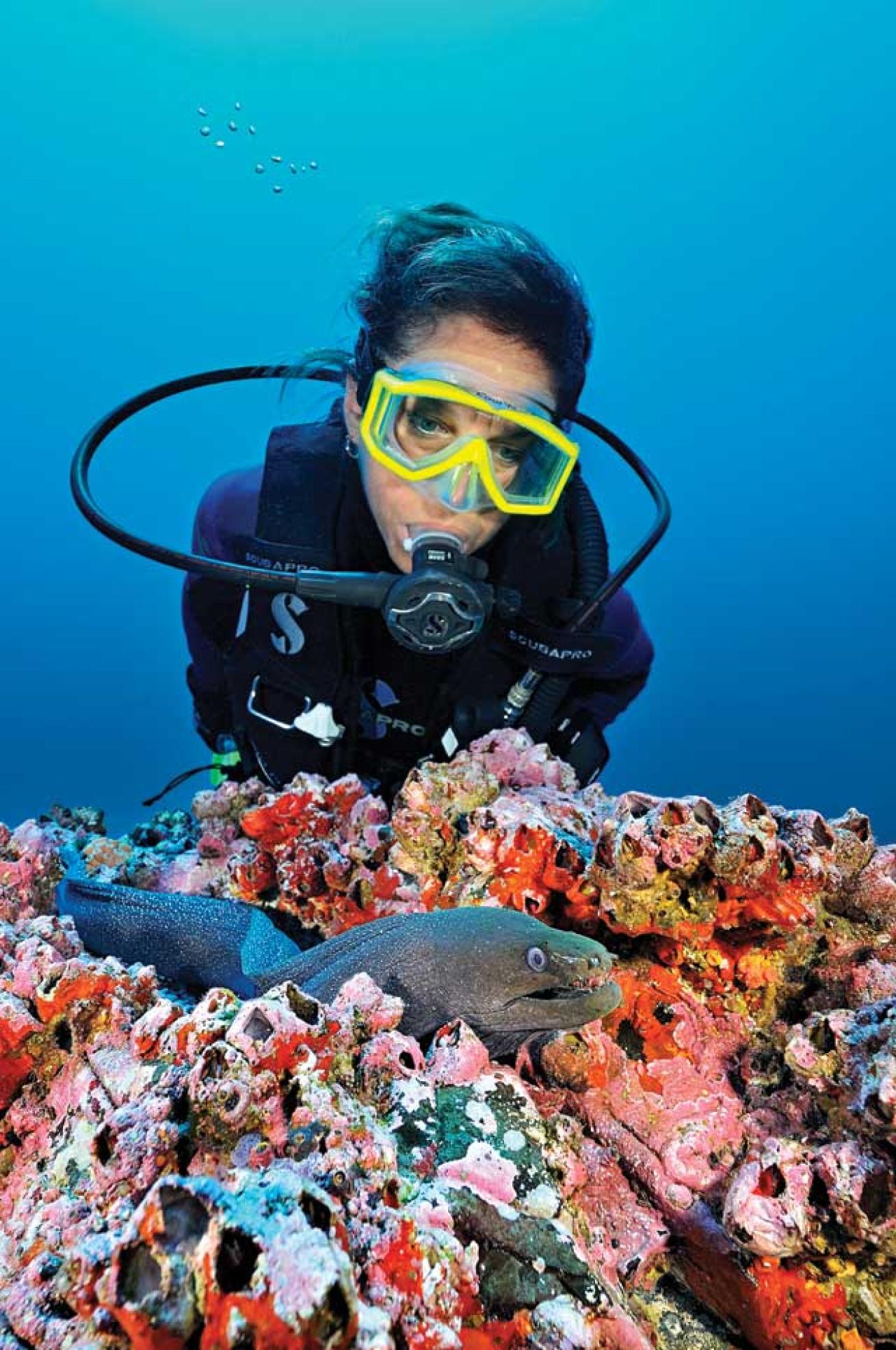
Scott JohnsonA diver explores the reef at Manuelita Island.
This massive whale shark hosts an astounding number of groupies that actually resemble the handiwork of some deranged fashion designer. Remoras clinging to its prodigious tail look like decorative flags, while others form a pseudo mustache and goatee as they are either packed inside the shark’s wide maw or riding upside down underneath it. There are even remoras stuffed inside its spiracles like radical head piercings.
Manuelita is only one of many electrifying dive sites around Costa Rica’s Cocos Island. This former pirate haven is 340 miles off the Costa Rican mainland in the eastern Pacific Ocean.
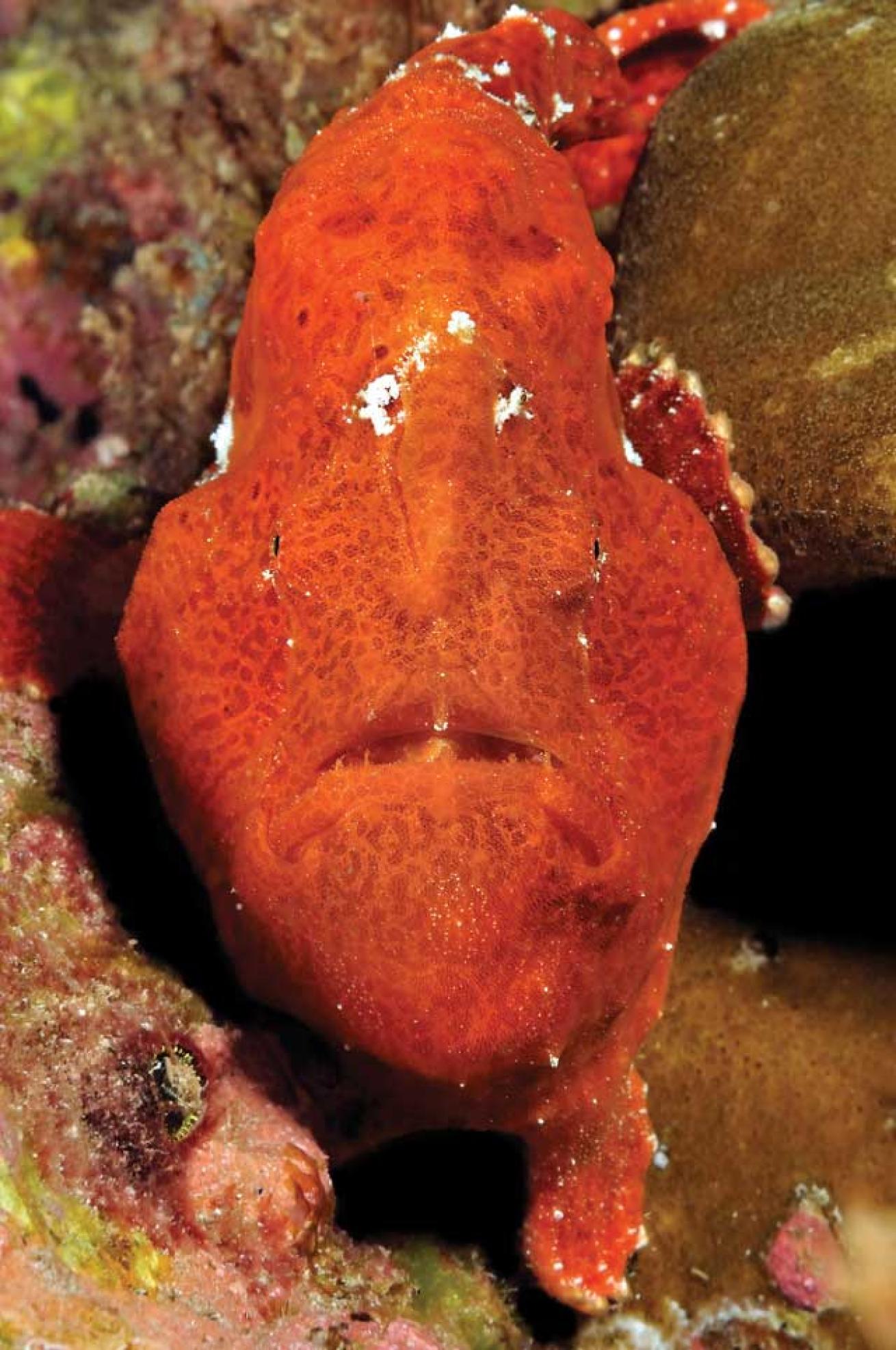
Scott JohnsonA Commerson’s frogfish in Manuelita’s coral gardens.
Cocos is the epitome of raw, wilderness diving. No other location offers the same dynamic, heart-pounding opportunities to dive with pelagics such as billfish, marine mammals, rays and sharks year-round. It’s not unusual for divers to see six species of shark — Galapagos, scalloped hammerhead, silky, tiger, whale and whitetip reef — on a single dive. Even marine mammals like bottlenose dolphin, false killer whales, humpback whales, killer whales and pilot whales are no strangers to the underwater playground of Cocos. The most productive pelagic hot spots are usually Alcyone, Dirty Rock, Manuelita and Punta Maria.
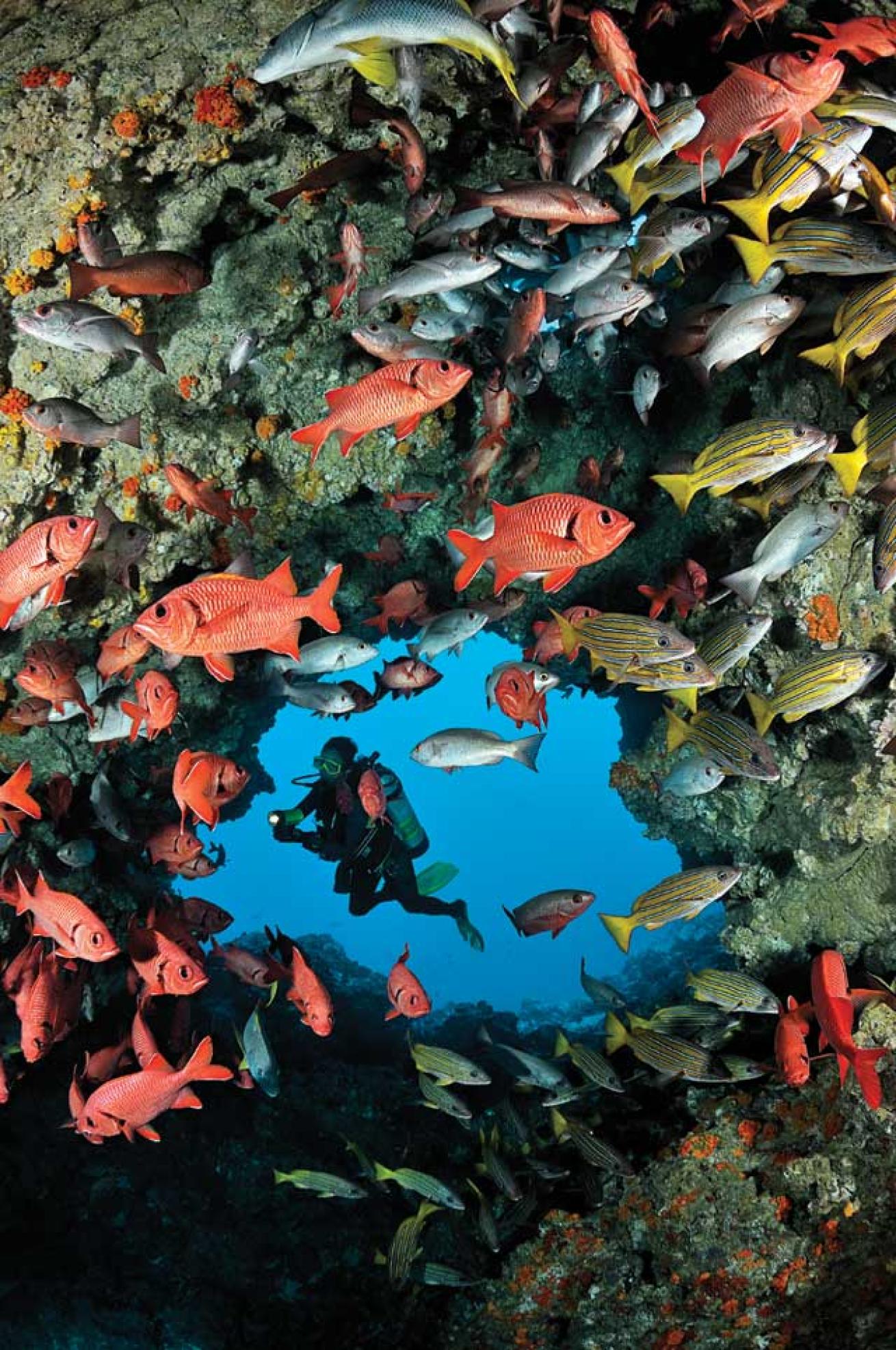
Scott JohnsonA diver explores a swim-through at Submerged Rock.
Legends of buried pirate booty have clung to Cocos through the ages. Though no golden doubloons have ever been found — or, at least, not publicized — small natural treasures abound on every site. It’s so easy to be fixated on the big prizes here that smaller jewels lie in anonymity. For instance, Manuelita’s protected coral gardens are home to stately Commerson’s frogfish and endemic red or rosy-lipped batfish.
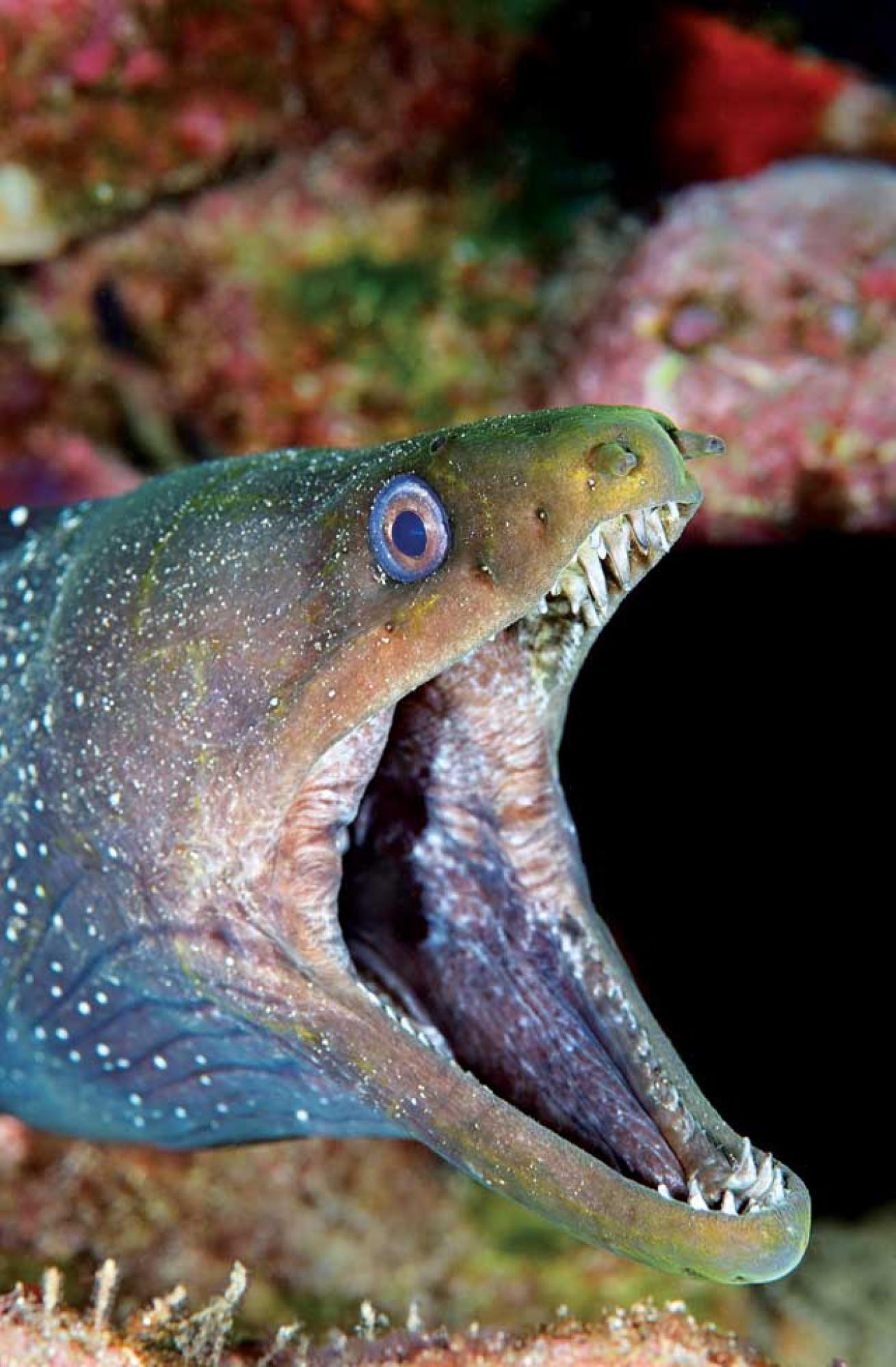
Scott JohnsonA fine spotted moray eel.
Need To Know
- When to Go Diving is good year-round. The rainy season (June to November) offers opportunities to swim with large schools of scalloped hammerheads but presents more-challenging conditions.
- Dive Conditions In the blink of an eye, conditions can change from site to site. Water temperatures range from 75 degrees F in the rainy season to 82 in the dry season. Thermoclines can drop temps 10 degrees. Visibility varies from 50 feet in the rainy season to more than 100 feet in the dry season.
- Logistics An overnight stay in San Jose is required upon arrival. The Okeanos Aggressor crew takes guests from San Jose to Puntarenas the following morning. All trips are 10 days long, with seven days of diving. Return transportation to San Jose is also provided.
- Operator Okeanos Aggressor is part of the Aggressor and Dancer Fleet.
- Price Tag A deluxe stateroom with a single and double bed is $4,935 per person; the quad stateroom with two double and two single beds is $4,535 per person.
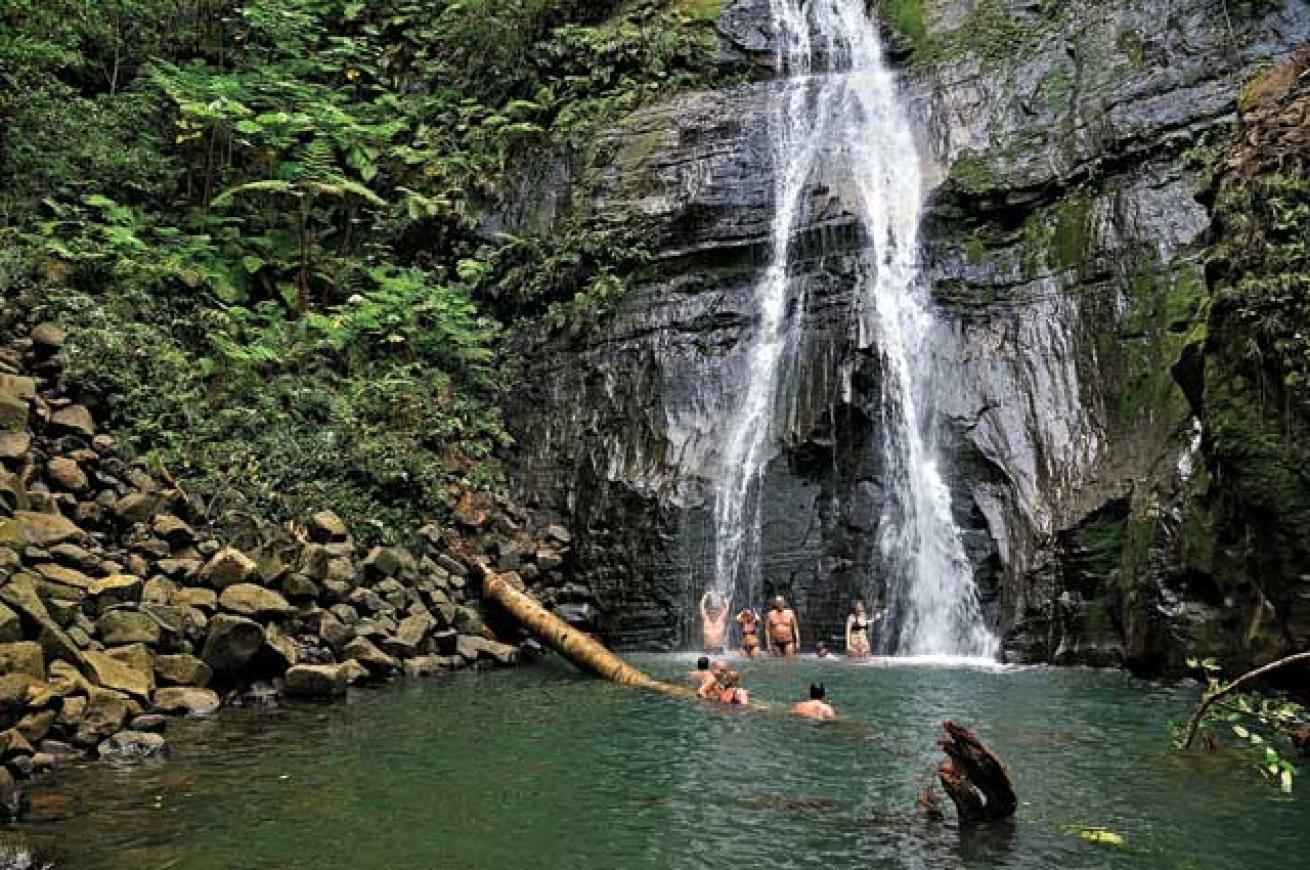
Scott JohnsonSplashing in at one of Cocos Island's waterfalls.
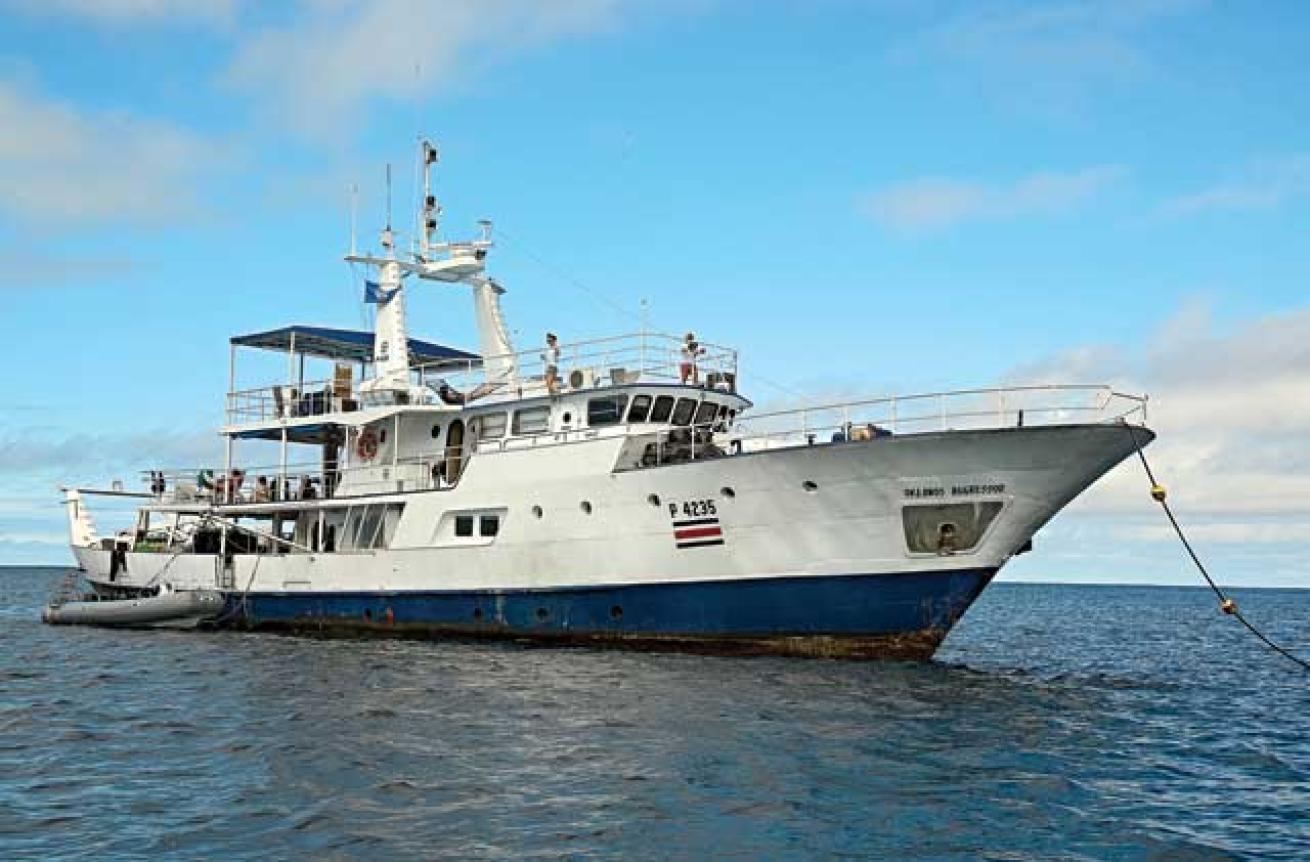
Scott JohnsonExperience all the wild action in Cocos aboard the Okeanos Aggressor.
Okeanos Aggressor
A liveaboard — and a 36-hour crossing — is the only way to reach and dive this remote, uninhabited paradise. A visit to this World Heritage site and the crown jewel of the country’s park system is a rare privilege that many consider the trip of a lifetime. Okeanos Aggressor is a luxury dive yacht that has been pampering divers from around the globe on Cocos Island charters since 1988. This vessel remains a cornerstone of the most successful and longest-standing fleet of premium liveaboards in the world. As such, it offers all the attention to details and first-class service that discriminating divers have come to expect from the Aggressor Fleet.
This powerful vessel was built to withstand the rigorous demands of open-ocean crossings, and is outfitted to cater to 22 passengers in style and comfort.
At a length of 110 feet and with a beam of 24 feet, Okeanos Aggressor features spacious accommodations, 10 staterooms with individual climate control, en-suite bathrooms and TV/DVD, as well as an expansive dive deck that gives photographers and nonphotographers alike plenty of room to don wetsuits and tinker with gear. Gourmet meals are served in a dedicated dining room. Sun lovers can soak in the rays on two different decks.
Three to four dives per day are conducted from a pair of nimble, 22-foot-long pangas. Currents, surge, thermoclines, visibility and animal sightings can change dramatically from one dive to the next: The experienced dive guides and panga drivers intimately know the sites, and put divers in the safest and most advantageous spots on each dive. Capt. Alberto “Beto” Muñoz has faithfully and passionately served on Okeanos Aggressor for the past 20 years, and still joyfully expects the unexpected on each and every dive.
Ten days aboard and a full week of diving Cocos flies past entirely too quickly. The lengthy return crossing offers plenty of time to dry and pack gear, read a book, watch movies, share tall tales with fellow divers, and rest before returning to the mainland. It is not, however, long enough to wrap my mind around the high-octane dives flush with exotic life, or the idyllic, tranquil settings that are so far removed from modern civilization. How can I adequately give anyone a true taste of what it’s like to get hammered at Cocos? I can’t. So I’ll just enjoy being pampered a little while longer while I try to figure out how I can swing another adventure aboard the Okeanos Aggressor.
5 Reasons To Dive Cocos From Okeanos Aggressor
1. Hammer Time
Schooling scalloped hammerheads symbolize the pelagic parade in the waters of Cocos Island throughout the year. The Okeanos Aggressor crew knows the prime parade routes and how to put their guests in front-row seats.
2. The Drama
Each dive site stages a never-ending drama of animal interactions and shifting marine forces. Cocos allows divers to look behind the curtains to see the raw, wild side of nature.
3. The Weird
Small, a-face- only-a-mother-could-love creatures — such as the Commerson’s frogfish and endemic red or rosy-lipped batfish — should not be missed.
4. The Beauty
Cocos is the only island in the eastern pacific that supports high-altitude cloud and tropical rainforests. About 200 waterfalls punctuate the lush landscape. Okeanos Aggressor’s decks let you soak in the intoxicating beauty.
5. Consistency
Okeanos Aggressor offers the same high standards of excellence in safety, service, comfort and guest satisfaction that are hallmarks of all Aggressor Fleet dive yachts.
Check out the entire slate of liveaboard itineraries offered by the Aggressor and Dancer Fleet!










